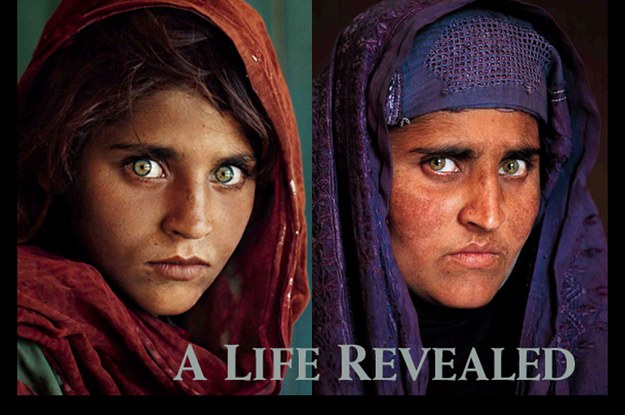From the Cover of National Geographic to a Mug Shot : A Well Thought Out Scream by James Riordan

One of the images that made the plight of the Mid-East refugees real to many Americans for the first time was the young girl with the green eyes on the cover National Geographic back in 1985. Phoyographer Steve McCurry saw her in a camp for displaced people in Peshawar, the largest city on the Pakistan/Afghanistan border. Her haunting image hit home with so many saying. “LOOK at the precious lives being squandered here!”
You might have seen her while sitting at a dentist’s office, or while bending over to pick up your mail, but whenever it was, it was hard to pull your eyes away. Her penetrating stare seemed to encompass the pain of Afghanistan’s civil war, and the perseverance of the refugees who fled it to Pakistan. Her name is Sharbat Gula and she was just 12 years old when she appeared on that cover. Now in her 40s, she is still in Peshawar, but as of this week, she is in police custody.
Green eyed lady, lovely lady
Strolling slowly towards the sun
Green eyed lady, ocean lady
Soothing every raging wave that comes*
GREEN EYED LADY, Recorded by Sugarloaf, Written by David Riordan;J.c. Phillips;Jerry Corbetta, Published by CLARIDGE MUSIC CO.
 Pakistani immigration officials detained her on charges that she possessed a fake Pakistani national identification card. They had been investigating her for years, and last year Pakistani media had published the picture attached to her allegedly fake identification card. As an Afghan national, she should not have been able to obtain such a card.
Pakistani immigration officials detained her on charges that she possessed a fake Pakistani national identification card. They had been investigating her for years, and last year Pakistani media had published the picture attached to her allegedly fake identification card. As an Afghan national, she should not have been able to obtain such a card.
Gula’s arduous life now has two famous photos as its bookends, the magazine cover and the mug shot. They tell a sad story of a woman at the mercy of war. When McCurry took her photo in 1984, Gula was not aware. She wouldn’t know of her own international fame until 2002, when McCurry returned to Peshawar in search of her.
Now, Gula is one of at least 1.5 million Afghan refugees who reside in Pakistan (some estimates are as high as 3 million), up from a onetime high of 5 million. The majority came during the country’s civil war in the 1980s, which very nearly left the entire country in ruins.
Afghanistan has not emerged from constant strife since and continues to be a major source of refugees, although many try to reach Europe instead of the overcrowded camps in Pakistan. Last year, 250,000 Afghan refugees in Pakistan actually returned home, according to the U.N. Many were seeing their “home country” for the first time; as many as three-quarters had been born in Pakistan.
The U.N. mission in Afghanistan on Monday reported a worrying increase in the number of civilians killed and wounded in the country this year, making it likely that 2016 will be the worst year since 2009, when the organization began keeping track.
According to the annual midyear report by the U.N. Assistance Mission in Afghanistan (UNAMA), 1,601 Afghans have been killed and 3,655 wounded so far this year. A full third of those casualties are children, representing an 18 percent increase over last year. Overall, there was a 4.4 percent increase in civilian casualties.
The numbers in the report are probably not comprehensive. With the Taliban gaining ground in southern Afghanistan, monitoring the effect of the war on civilians there is presumably increasingly difficult. On the other hand, UNAMA doesn’t release its data set, so it isn’t possible to know for certain whether that assumption is true.
 Of the available data on casualties, almost two-thirds were attributed to “antigovernment elements” and a quarter to “pro-government forces.” This represents a major increase in casualties caused by the Afghan and U.S. militaries. Part of that spike is explained by the doubling in civilian casualties caused by airstrikes, though those strikes account for only a small portion of the total. Fifty casualties were attributed to U.S. airstrikes in particular.
Of the available data on casualties, almost two-thirds were attributed to “antigovernment elements” and a quarter to “pro-government forces.” This represents a major increase in casualties caused by the Afghan and U.S. militaries. Part of that spike is explained by the doubling in civilian casualties caused by airstrikes, though those strikes account for only a small portion of the total. Fifty casualties were attributed to U.S. airstrikes in particular.
Almost 40 percent of civilian casualties this year were caused by “ground engagement.” A haunting testimony included in the UNAMA report gives a sense of what that looks like. It comes from an unnamed man in the southern province of Kandahar.
“It was in the evening time and my wife, children, and mother were at home. Taliban attacked an Afghan National Army checkpoint and they both started firing mortars and rockets at each other. A mortar round exploded in my house, killing my 8-year-old daughter and injuring my 7-year-old son and my wife. We were hysterical, running from one side of the house to another thinking that another mortar round would hit the house. Since that moment, I have no life any more. My mother, brothers, sisters and relatives buried my daughter and took the injured to hospital for treatment. I am in sorrow for the death of my daughter and the injury of my beloved son and wife. Now I cannot afford their treatment or to feed my mother and the rest of my family.”
Another major cause of casualties are improvised explosive devices, or IEDs. The report notes that 85 percent of those killed or wounded by IEDs this year are children.
“Platitudes not backed by meaningful action ring hollow over time,” said Tadamichi Yamamoto, the United Nations’ top official in Afghanistan. “History and the long memory of the Afghan people will judge leaders of all parties to this conflict not by their well-meaning words, but by their conduct.”
 Pakistan is trying to persuade Afghan refugees to return home, even as recent violence pushes more Afghans to flee. Pakistani authorities have struggled to register the refugees, and amid the confusion, many obtain fake documents like Gula’s. Pakistan’s National Database Registration Authority (NADRA) says that it has detected 60,675 cards that may be illegal. Pakistan has tried to persuade refugees to leave since 2009, although it has consistently pushed back a supposedly hard deadline to do so each year. The U.N. recently doubled its cash incentive for refugees to move back to Afghanistan to $400.
Pakistan is trying to persuade Afghan refugees to return home, even as recent violence pushes more Afghans to flee. Pakistani authorities have struggled to register the refugees, and amid the confusion, many obtain fake documents like Gula’s. Pakistan’s National Database Registration Authority (NADRA) says that it has detected 60,675 cards that may be illegal. Pakistan has tried to persuade refugees to leave since 2009, although it has consistently pushed back a supposedly hard deadline to do so each year. The U.N. recently doubled its cash incentive for refugees to move back to Afghanistan to $400.
A major source of worry for Pakistan is that a thriving fake document business allows militants from across the border to move freely within Pakistan. For instance, in May, when a U.S. drone strike killed Taliban leader Mullah Akhtar Mansoor, such fake documents were found on his person.
 Shahid Ilyas, an official at NADRA, told the media that Gula faces seven to 14 years in prison and a fine of $3,000 to $5,000 if convicted.
Shahid Ilyas, an official at NADRA, told the media that Gula faces seven to 14 years in prison and a fine of $3,000 to $5,000 if convicted.
___




No Comment